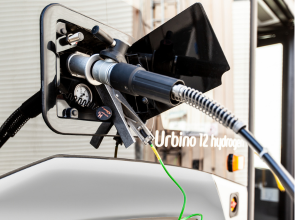AVL foresees hydrogen IC-based powertrain is comparable to rivals in costs

AVL, an Austria based automotive consulting firm conducting development, simulation and testing of powertrain systems, develops a hydrogen internal combustion engine to be used in a conventional powertrain without hybridisation.
The company is currently developing a hydrogen internal combustion engine and using a 12.8 l natural gas engine as a base with a set performance target at 350kW. The engine is targeted to be used in a typical long haul tractor. The focus of the development is to demonstrate CO2 neutral propulsion with a conventional powertrain for the vehicle segments, which are mainly targeted by the EU CO2 reduction roadmap.
“The vehicles which are mainly contributing to the road based greenhouse-gas emissions of goods transport are typically equipped with 11-13 l engines with power ratings up to 350 kW,” AVL told H2 Bulletin.
AVL used a modern natural gas engine as a base engine for hydrogen conversion, which is capable of running with two different fuel injection systems. Multipoint hydrogen injection into the intake manifold as well as direct hydrogen injection into the combustion chamber. The two fuel injections systems are not going to be operated parallel. The target is to have a clear comparison of the benefits and disadvantages of both injection principles on one particular engine.
To deal with the thermodynamic specific behaviour of hydrogen, the air handling system, e.g. turbocharger and EGR, is amended. The ideal combustion of hydrogen in air produces only water vapour as a product. However, when hydrogen as the fuel is combusted in an internal combustion engine, it results in the formation of water vapour and NOx emissions.
Therefore, to keep the NOx emissions as low as possible during the combustion process, higher excess air ratios are required than for a diesel engine. Therefore, the focus is to match the turbocharger perfectly to ensure optimal dynamic response with the lowest NOx emissions. To reduce the engine NOx emissions to an even lower level, an AdBlue based SCR catalyst is being used as an exhaust gas after-treatment system.
“The AVL Hydrogen Engine as of now is a technology demonstrator and not intended to go into production,” the company confirmed to H2 Bulletin. The company’s current aim is to show the potential for performance, efficiency, and how to ensure future emission legislation requirements. The industrialisation of such kinds of engines appears to be feasible ahead of 2025.
With such a timeline, the hydrogen combustion engine could be an option for hydrogen-fuelled goods transport, building up the needed hydrogen fuelling infrastructure. This infrastructure could be used by fuel cell electric trucks later on as well.
Several engine manufacturers have explored hydrogen combustion engine technology. An Italian consortium is working on developing a hydrogen combustion engine powered bus for the operation in the Emilia-Romagna region. In addition, other truck manufacturers, e.g. Man, Scania, have recently announced that they will develop or research hydrogen combustion engines.
“Hydrogen combustion engine based powertrains can achieve quite comparable costs to diesel or natural gas engine based powertrains,” AVL pointed out to H2 Bulletin. Indeed, on the vehicle level, the storage of hydrogen in compressed or even liquified way requires significantly more expensive tank solutions. As hydrogen currently is an expensive energy carrier, fuel consumption is of vital importance. Therefore efficiency is one of the key development targets of AVLs Hydrogen Engine, and the achieved 42 % BTE is proof of the potential of the technology.
